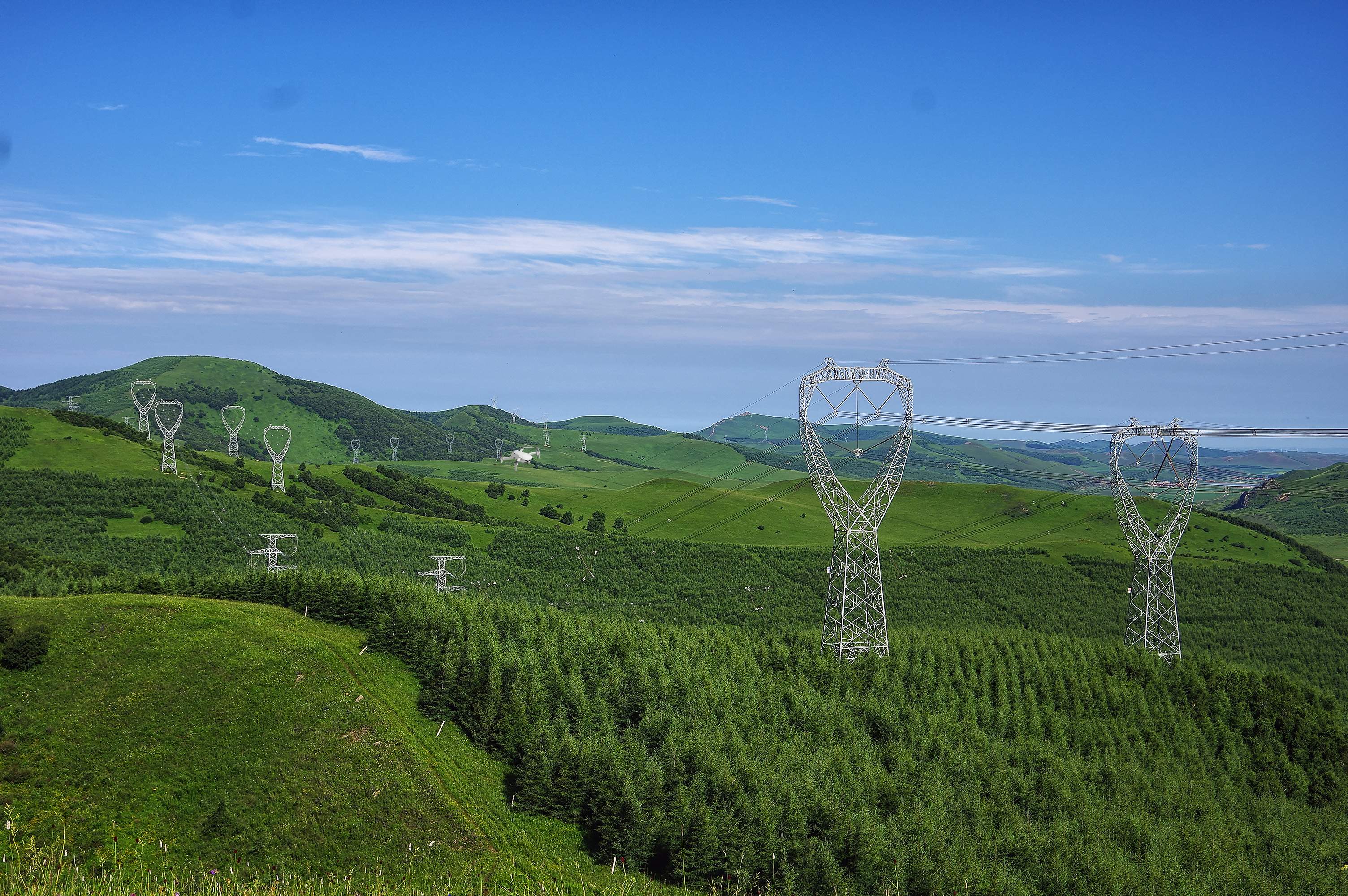Solution to Wireless Communication Problems of Unmanned Aerial Vehicles for Power Inspection in Mountainous Areas
When conducting power line inspections in mountainous areas, drones often encounter complex geographical environments and severe communication challenges. The terrain in mountainous regions is highly undulating, with mountains and forests severely obstructing wireless signals, leading to unstable communication between the drones and the ground control station. This can result in signal interruptions and increased latency, hindering the smooth progress of inspection tasks. Moreover, the variable climatic conditions in mountainous areas, such as heavy rain, thick fog, and strong winds, can also interfere with wireless communication signals, further complicating communication.

I. Solution to Communication Issues
(1) Integration of 5G and Satellite Communication Links
In the areas near the edge of the mountainous region where 5G signal coverage is available, drones prioritize using the 5G network for data transmission and receiving control instructions. The 5G network is based on key technologies such as orthogonal frequency division multiplexing (OFDM) and massive multiple-input multiple-output (Massive MIMO), featuring high bandwidth and low latency. Its theoretical peak download rate can reach 20 Gbps, the upload rate can reach 10 Gbps, and the latency can be as low as 1 ms. It can support drones to quickly transmit high-definition inspection images, such as 4K or even 8K resolution videos, ensuring that ground control personnel can clearly view the details of the power lines. At the same time, the low latency feature ensures that the control instructions of the operators can be promptly conveyed to the drones, guaranteeing flight safety and the accurate execution of inspection tasks.
When the unmanned aerial vehicle (UAV) penetrates into the interior of the mountainous area, the 5G signal weakens or disappears, and the satellite communication link automatically activates. The Beidou satellite communication system, with its global coverage capability, ensures that the UAV can still maintain contact with the ground control center in remote mountainous areas. The Beidou system adopts a three-frequency signal system, which can effectively eliminate ionospheric delay errors and improve the stability and accuracy of communication. The UAV transmits the collected power line data, such as line temperature and insulator status, back to the ground control center through the Beidou communication module it is equipped with.
To achieve seamless switching between 5G and satellite links, we employ an intelligent switching algorithm based on deep learning. This algorithm analyzes real-time parameters such as 5G signal strength, signal-to-noise ratio, and latency, and combines the availability prediction of satellite links to plan the switching strategy in advance. During the switching process, by utilizing data caching and retransmission mechanisms, the data transmission packet loss rate is controlled below 0.1%, ensuring the integrity of inspection data. For instance, when the unmanned aerial vehicle is about to enter a 5G signal blind area, the algorithm initiates the preparation for satellite link connection in advance, completing the link switch before the 5G signal drops below the threshold, thus ensuring uninterrupted communication.
(2) Self-organizing network enhanced signal relay
Multiple unmanned aircraft form an inspection formation and utilize the self-organizing network technology to establish a dynamic communication network. The self-organizing network is based on the Ad Hoc network architecture, where nodes do not need to rely on fixed infrastructure and can quickly and autonomously form network connections. When one of the unmanned aircraft enters an area with severe signal obstruction, the surrounding unmanned aircraft with good signals automatically act as signal relay nodes. Through multi-hop transmission, the data of the affected unmanned aircraft is forwarded.
Take the valley area as an example. When the drone ahead is blocked by the mountain and its signal is obstructed, the drone behind, through the link quality detection mechanism, detects a sudden drop in the signal strength of the drone ahead and promptly adjusts the self-organizing network topology structure. The self-organizing network algorithm based on reinforcement learning will re-plan the data transmission path based on real-time network topology, remaining battery power of nodes, data traffic and other information. The algorithm continuously experiments and learns to optimize node selection and routing strategies. In complex and variable mountainous environments, it can complete network structure optimization within hundreds of milliseconds to ensure the stability and timeliness of communication. At the same time, to reduce data transmission delay, data compression technology is adopted to perform real-time compression processing on the inspection data. Without affecting the accuracy of the data, it reduces the data transmission volume and improves transmission efficiency.
(3) Precise Tracking by Smart Antennas
The unmanned aircraft is equipped with a phased array intelligent antenna. This antenna is composed of an array of multiple antenna units. By controlling the phase and amplitude of each unit, the electronic scanning of the beam is achieved. The phased array intelligent antenna can dynamically adjust the antenna beam direction by real-time perception of the direction of the ground control station or satellite signals. During flight in mountainous areas, even if the signal is interfered by multiple reflections caused by mountains, trees, etc., the intelligent antenna can utilize the multi-path signal synthesis technology to extract effective signals from the complex signal environment and enhance the signal reception strength.
The specific workflow is as follows: Firstly, multiple antenna units in the antenna array receive signals from different directions. After being processed by the RF front-end, the signals are converted into digital signals. Then, the digital signal processing unit analyzes these signals and calculates the direction of signal arrival (DOA) through algorithms. Next, based on the DOA information, the phases and amplitudes of each antenna unit are adjusted to direct the antenna beam towards the signal source, achieving directional reception and transmission of signals. For example, when a drone is flying in a dense forest area, the intelligent antenna can automatically identify and lock onto the strongest signal direction within milliseconds, overcoming the attenuation of signals by trees, and maintaining a stable communication connection. At the same time, to cope with rapid changes in signals, the beam adjustment frequency of the intelligent antenna can reach several thousand times per second, ensuring good communication performance during the high-speed flight of the drone.
II. Equipment Installation and Adaptation
(1) Modular protective installation
The 5G communication module, satellite communication module and self-organizing network module are integrated into a sturdy protective capsule. This protective capsule is made of high-strength composite materials and has IP67-level waterproof and dustproof performance, capable of withstanding harsh weather conditions such as mountain rainstorms and sandstorms. At the same time, through a special shock absorption structure design, it can effectively absorb the vibrations during the drone's flight, adapting to the bumpy environment caused by the complex terrain in the mountains. The protective capsule is installed at the center of the drone's weight, and through precise weight distribution calculation and installation and adjustment, it ensures that the flight balance is not affected.
In addition, each communication module is equipped with an independent cooling device. Considering the large temperature variations in mountainous environments, the cooling device adopts a combination of active and passive cooling methods. The active cooling part uses micro fans and heat-conducting tubes to quickly transfer the heat generated by the module to the heat sink; the passive cooling part increases the surface area of the heat sink to use air convection for cooling. During long-duration flights, the temperature of the module is monitored in real time by a temperature sensor. When the temperature exceeds the set threshold, the fan speed adjustment mechanism is automatically activated to ensure that the module can operate stably within the normal working temperature range.
(2) Antenna Optimization Layout
The intelligent antenna array is designed with an embedded structure and is closely integrated with the drone's shell. This not only reduces air resistance during flight but also enhances the antenna's protection performance in harsh mountainous environments. Regarding the installation angle, after multiple simulation tests and on-site verifications, the antenna angle was adjusted to maximize the reception of ground signals while also considering the direction of satellite signals. Specifically, in the horizontal direction, a certain range of deflection is reserved for the antenna to face the ground control station direction to accommodate the attitude changes of the drone during flight; in the vertical direction, it is tilted at a certain angle to ensure effective reception of satellite signals at different flight altitudes.
At the same time, in order to avoid mutual interference between antennas, reasonable physical isolation and electromagnetic shielding designs are carried out for 5G antennas, satellite antennas and ad-hoc network antennas. By setting metal shielding layers between the antennas and optimizing the layout spacing of the antennas, the interference between antennas is suppressed below -30dB, ensuring that each antenna can work independently and efficiently, and improving the overall communication performance.
III. Implementation Process and Assurance Measures
(1) Preliminary Planning and Preparation
Before carrying out the power inspection task in mountainous areas, the terrain and signal conditions of the inspection area were thoroughly mapped and evaluated using Geographic Information System (GIS) and unmanned aerial vehicle (UAV) aerial survey technology. Based on the GIS data, the terrain trends and vegetation coverage in the mountainous areas were analyzed, and the flight routes of the UAV were planned to avoid areas with severe signal blockage. The high-precision three-dimensional terrain model was obtained through aerial survey technology, and combined with 5G and satellite signal coverage prediction models, the signal strength and quality in different areas were evaluated to provide a basis for the parameter configuration and working mode selection of communication equipment.
At the same time, professional training is provided for the operators, covering aspects such as drone operation skills, principles and usage of communication equipment, and emergency handling procedures. Through theoretical learning and simulation operations, the operators can become familiar with the communication characteristics and response strategies of drones in complex mountainous environments, enhance their emergency handling capabilities, and ensure that they can operate the equipment correctly and handle communication failures promptly during the inspection process.
(2) On-site Implementation and Monitoring
At the inspection site, a ground control center is established, equipped with high-performance communication base stations and data processing servers. The communication base stations are responsible for wireless communication with the unmanned aircraft, enabling the transmission and forwarding of data; the data processing server conducts real-time processing and analysis of the inspection data sent back by the unmanned aircraft, such as identifying defects in power lines and assessing their status. At the same time, through the monitoring system, the flight status, communication signal strength, battery power and other parameters of the unmanned aircraft are monitored in real time. Once any abnormal situation is detected, an alarm is immediately issued and corresponding emergency handling measures are initiated.
During the flight of the unmanned aerial vehicle, the operator adjusts the flight altitude, speed and attitude of the UAV flexibly based on the real-time communication signals and flight status to optimize the communication effect. For instance, when encountering signal obstruction, the flight altitude can be appropriately increased to avoid the obstruction of the signal by obstacles; when the communication signal is unstable, the flight speed can be reduced to minimize the signal fluctuations caused by rapid movement.
(III) Post-implementation Maintenance and Optimization
After the inspection task is completed, a comprehensive inspection and maintenance of the communication equipment is carried out. Check whether the connections of the communication modules are loose, whether the antennas are damaged, and whether the cooling devices are working properly; clean the equipment to remove dust, sand and other debris, ensuring that the equipment is in a good working condition. At the same time, analyze the communication data collected during the inspection process, summarize communication problems and optimization experiences, and provide references for subsequent inspection tasks.
Based on the actual application scenarios and technological development trends, the communication solutions are continuously optimized and upgraded. For instance, new communication technologies such as 6G and terahertz communication are introduced to enhance communication performance; the intelligent algorithms are optimized to improve the self-adaptive ability and fault handling capability of communication equipment; the hardware design of the equipment is improved to enhance the reliability and adaptability of the equipment, so as to better meet the needs of power inspection in mountainous areas.
IV. Effect Evaluation and Expected Returns
(1) Evaluation Indicators for Effectiveness
Communication stability: By analyzing indicators such as the number of communication interruptions, interruption duration, and data packet loss rate during the inspection process, the stability of the communication link is evaluated. The goal is to keep the number of communication interruptions below 0.5 times per hour, with the cumulative interruption time not exceeding 1 minute per hour, and the data packet loss rate below 0.1%.
Data transmission efficiency: Measures the transmission rate and latency of high-definition inspection images, power line data, etc. It is required that the transmission rate of 4K video be no less than 50Mbps, the control command latency be no more than 50ms, and ensure that ground control personnel can obtain inspection information in real time and clearly, and control the unmanned aircraft promptly.
Equipment reliability: Analyze the failure rate of communication equipment in the complex environment of mountainous areas. The goal is to keep the equipment failure rate below 5% per year, ensuring the stable operation of the equipment during long-term inspection tasks.
(2) Expected Returns
Improving inspection efficiency: Compared with the traditional manual inspection method, unmanned aerial vehicle (UAV) inspection can quickly cover large areas of mountainous power lines and shorten the inspection cycle. It is expected that the inspection efficiency can be increased by 3 to 5 times, significantly reducing labor and time costs.
Improving inspection accuracy: The high-definition cameras and various sensors installed on the unmanned aerial vehicles can clearly capture the details of power lines, accurately detect line defects and faults. Through automated data processing and analysis, the accuracy of defect identification is enhanced, and errors and omissions caused by human factors are reduced.
Ensuring the safety of inspection personnel: The mountainous terrain is complex and the environment is harsh, and manual inspection poses many safety hazards. By using unmanned aerial vehicles for inspection, it is possible to prevent inspection personnel from entering dangerous areas, reduce the probability of accidents, and ensure the safety of personnel lives.
Reduce operation and maintenance costs: Timely detection and resolution of power line faults can minimize power outages and economic losses caused by line failures. Through precise inspections and maintenance, the service life of power equipment can be extended, thereby reducing the overall operation and maintenance costs.
Through the above solution, the communication problems of the unmanned aerial vehicles for power inspection in mountainous areas can be effectively solved, thereby improving the inspection efficiency and safety, promptly detecting potential problems in power lines, and ensuring the stable and reliable power supply in mountainous areas.








